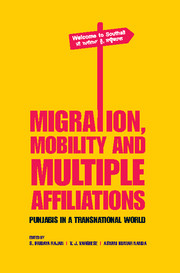Book contents
- Frontmatter
- Contents
- List of Tables and Figures
- Preface
- Acknowledgements
- Transnational World and Indian Punjab: Contemporary Issues
- Part I A Historical Survey
- Part II Shifting Contours of Migration
- Part III Social Structures and Organizational Links
- Part IV Education and Migration
- Part V Family Networks
- Contributors
- Index
Transnational World and Indian Punjab: Contemporary Issues
Published online by Cambridge University Press: 05 March 2016
- Frontmatter
- Contents
- List of Tables and Figures
- Preface
- Acknowledgements
- Transnational World and Indian Punjab: Contemporary Issues
- Part I A Historical Survey
- Part II Shifting Contours of Migration
- Part III Social Structures and Organizational Links
- Part IV Education and Migration
- Part V Family Networks
- Contributors
- Index
Summary
Introduction
The Punjabi transnational experience injects a distinct flavour to Indian transnationalism. With a history of sustained migration for more than two centuries beginning primarily during colonial rule of India, the entry into transnational life from Punjab has been enormous. Though members of Punjabi diaspora share a common cultural, as well as linguistic, identity yet in terms of religion and socio-economic characteristics, this diaspora is sufficiently diverse. Originating in the Punjab region of undivided India that was bifurcated by the Radcliffe Line in 1947 into eastern and western parts to become the separate provinces in independent India and Pakistan respectively, this diaspora is spread across more than 75 countries of the world with major concentrations in United Kingdom (UK), United States of America (USA), Canada, Australia, Southeast Asia and Middle East.
The history, growth and size of the Punjabi diaspora are critical to the understanding of its role in the transnational sphere. In spite of an extensive presence across many parts of the world and global vibrancy in various fields such as trade, industry, agriculture, healthcare, politics, arts, culture, music, entertainment, spiritualism, charity, etc., precise information is not yet available on the numerical strengths of the Punjabi diaspora. There is a lack of reliable and comparable data on several aspects regarding the Punjabi communities abroad. This constraint, coupled with definitional limitations in national surveys and census, both at the destination as well as origin countries, have resulted in a lack of proper understanding of transnational activities and their implications. Inadequate recognition of the contributions by the immigrants in host society and the rising trend of moving away from ethnic statistics often contribute to lack of diaspora statistics in many societies. Notwithstanding the data deficiencies, it is believed that Punjabis are one of the largest ethnic groups in the 2.5 million strong Indian diaspora – with their size touching nearly eight million (Saroya, 2008, 43).
One major cause of rising interest in Punjabi transnationalization is the consistent increase in the number of Punjabi immigrants abroad – particularly in the third quarter of the twentieth century – despite the ‘rising walls’ in favourite destination countries. Successful negotiation with changing immigration regimes using both formal and informal rules abroad is living testimony to the perseverance of migrants from Punjab in securing entry, residence and livelihood abroad.
- Type
- Chapter
- Information
- Migration, Mobility and Multiple AffiliationsPunjabis in a Transnational World, pp. 1 - 36Publisher: Cambridge University PressPrint publication year: 2015
- 1
- Cited by



